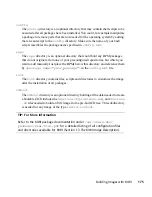
13.3 Creating the KIWI Image
After the image preparation has finished successfully, proceed with creating the image:
1
Run the imaging command:
kiwi --create ./chroot/graphical-default --destdir
./images/graphical-default
KIWI creates the system image as well as any additional files needed to deploy
the image. Find the result of the imaging process under
/var/lib/SLEPOS/
system/images/graphical-default
.
2
Check whether the resulting image matches your needs. If not, you may modify
the image configuration inside the prepared physical extend, by either:
• editing the files under
/var/lib/SLEPOS/system/chroot/
graphical-default
, or
• entering the chroot environment with
chroot
/var/lib/SLEPOS/system/chroot/graphical-default
, using
the utilities available in the image to edit the configuration, and exiting the
chroot environment with
exit
.
Re-run the imaging command:
kiwi --create ./chroot/graphical-default --destdir
./images/graphical-default
For more information on the KIWI command and the options available to it, run the
kiwi --help
command.
NOTE: Building SUSE Linux Enterprise 10 Images
For building SUSE Linux Enterprise 10 images, we recommend using a SUSE
Linux Enterprise 10 build machine. However, you can also build SUSE Linux
Enterprise 10 images with the KIWI version included in SUSE Linux Enterprise
11, if needed. In this case, make sure to add the following option when running
the image command
--fs-inodesize 128
180
SUSE Linux Enterprise Point of Service Guide






























